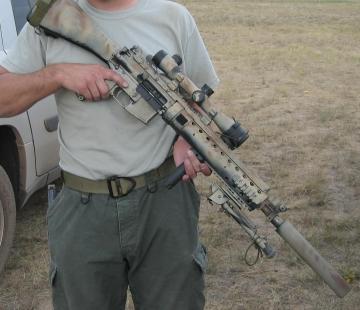
 The canonical Type III scope is the Leupold 3-9x36 mm MR/T, shown here on a SPR. Higher
magnification and external turrets enable precise engagements on small and distant targets.
Finally, Type III sighting systems have the capability to take the rifle to its ballistic limit and
to engage very small target at extended ranges. The 18-inch Mk12 Mod 1 Special Purpose Rifle (SPR)
uses such an optic, so it makes sense to call it an SPR optic. Military-issue 5.56 loads
fired from a 16-inch barrel go subsonic between 600 and 800 yards at sea level, and this defines the
longest possible engagement distance. Keep in mind that the terminal energy of 5.56 at this
distance is very low, however, the SPR has made kills at over 600 yards using 77-grain ammunition.
The other advantage these have over the Type II or DMR optic is the ability to see and engage very
small targets at intermediate and long distances. When fighting opponents who are partially behind
cover or wearing armor, the ability to ID targets and place a head shot several hundred yards away
can be key.
The Type III optic is generally a variable magnification scope with a maximum power of 9x to 12x.
The reticle is typically some type of mil-dot or mil-hash, and has lines thin enough to discern a
sight picture on 2 MOA targets. In order to compensate for bullet drop and wind drift at longer
distances, the Type III optic usually has external knobs. At close distances, the scope
magnification can be dialed down to somewhere between two and four power for faster target
acquisition or tracking moving targets.

 Although its size and weight dominate the rifle, the US Optics 3.2-17x44 mm SN3 scope makes trivial
work of small targets beyond 400 yards-- although the 5.56 mm cartridge isn't always up to it.
The Type III optic is basically a long-range rifle scope with the features required for tactical or
practical engagements, so it is no surprise that a lot of scopes more often seen on long-range
bolt-action sniper rifles turn up on AR-15s in this role. The geometry of the AR-15 platform,
however, complicates the choice. Conventional scopes have eye relief over three inches, which means
the ocular lens of the scope will have to be mounted about three inches forward of the charging
handle for most shooters. This requires either a cantilevered mount such as the LaRue SPR or SPR-E
mounts, or a raised and extended rail such as the full-length ARMS rail on the SPR. With a scope
mounted this far forward, the carbine can end up muzzle heavy, and the scope's objective can
conflict with rail mounted devices such as an AN/PEQ-4. The size of the optic can also dominate the
AR-15 carbine.
The canonical Type III or SPR optic is the Leupold Mark 4 3-9x36 mm MR/T with a one-MOA M1 elevation
knob. Leupold developed this scope specifically for the SPR program; its small size, low weight,
and slightly shorter than normal eye relief are good matches to the AR-15 platform. Leupold has
recently come out with a 2.5-8x36mm MR/T in M1 (1/4 MOA), M2 (1/2 MOA), and M3 (1 MOA) knob
configurations. None of these have a first focal-plane reticle configuration, so the reticle
features can only be used for ranging or hold-off at the top magnification setting. These Leupold
MR/T scopes cost $900 to $1100. Nightforce's 2.5-10x24 NXS fits right in with the Leupold models.
Its elevation knob is capped and has 10 MOA per turn in 1/4 MOA clicks, and no zero stop. It sells
for about $1200.
If you are willing to step up to a larger scope size and deal with the eye relief and mounting
issues, there are considerably more choices, including the Leupold Mark 4 3-10x40mm LR/T, US Optics
1.8-10x44 mm SN3, and Schmidt and Bender 3-12x50mm PMII. The Schmidt and Bender was recently
adopted as the new daylight scope for the USMC M40A3 sniper rifle and is a superlative though very
expensive piece of glass. The US Optics SN3 is about $1600, while the S&B PMII is $2800.
|